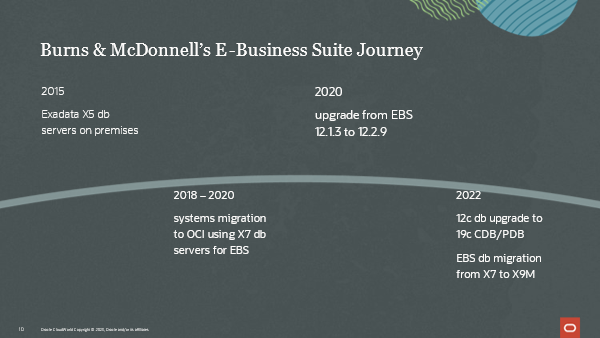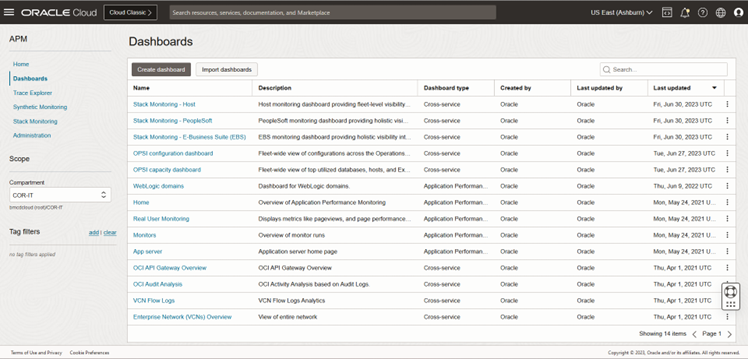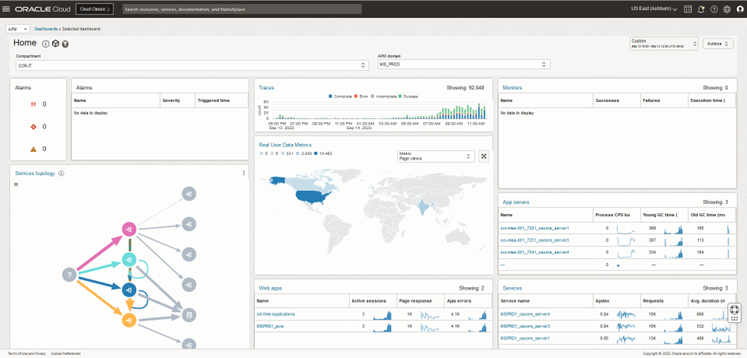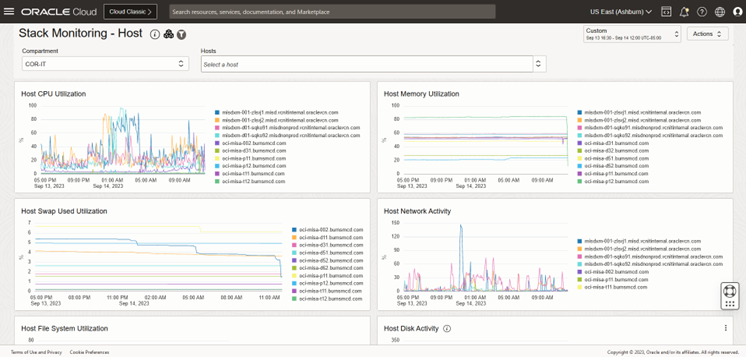Guest Author – Jeff Kirk, DBA Manager – Burns & McDonnell
Contributors: Brian Hengen, Vice President, Cloud Engineering – Oracle, Atul Behari, Director, Cloud Engineering – Oracle
This blog highlights Burns & McDonnell’s use of Oracle Cloud Infrastructure. Mr. Jeff Kirk presented at Oracle CloudWorld and shared his experience and the key benefits they are working toward at Burns & McDonnell.
Burns & McDonnell is a leading design and construction firm that has been using Oracle Applications for full HR, and core financial deployment to a highly customized version of Oracle Project Costing since 2000. In 2015, they started their E-Business journey with Exadata X5 database servers on-premises. Since then, they have migrated their systems to OCI using X7 database servers for EBS in 2018, upgraded to EBS 12.2.9 in 2020, and upgraded to 19c CDB/PDB with EBS database migration from X7 to X9M in 2022.

Key requirements for an E-Business suite upgrade
The pain points they experienced with the EBS Administration included the inability to quantify their performance problems. Instead of the system being slow, they wanted to be able to measure what was making it slow and why. Burns & McDonnell experienced a support intake process that wasn’t user-friendly, had unconstrained external and internal workloads to manage, and needed user-friendly tools for EBS system visibility. Oracle provided an integrated comprehensive management solution for EBS with Full stack monitoring including end-user monitoring, problem resolution, and analytics to address their pain points. With Stack Monitoring, they can see enterprise-wide resources including hosts, Databases, app servers, and EBS environments. Now they have drill-down capability into resource details and can see the relevant environment information in multiple dashboards. The visibility to real-time environment status affords them a view of their workflow with detailed status via hovering over their EBS graphs. Quick visibility of app server load issues helps them address where their performance issues are occurring and how to fix them. EBS Discovery with Stack Monitoring is made easy with the use of a resource discovery submission form that provides host and connection details and takes minutes to identify and monitor new environment resources.
Burns & McDonnell is making implementation progress with automated discovery. Currently, the refresh of an E-Business application is a manual process involving CLI commands and JSON files. Each time a refresh is executed, Stack Monitoring rediscovers the forms cluster that is not used. This creates the need to delete the cluster time each time EBS is refreshed. Oracle development is working on an enhancement to the refresh of an EBS application with the click of a button. Then, the discovery and refresh of an EBS application will ignore disabled EBS resources for services that are not being used.
How Oracle Cloud Dashboards track operational efficiency
Database Management information being captured by Burns & McDonnell includes a wide array of data related to timelines, average active sessions, open alarms, CPU utilization, and more. Here are some of their dashboards being managed:
-
Application Performance Monitoring Dashboards provide them with fleet-level visibility across their E-Business suite.
- Various views from a pane of glass
- Duplicate to modify for custom view

-
Home dashboards with alarms, traces, services topology, and real user data metrics
- Visualize application server activity volumes easily with arrow size
- Drill down and see where the activity is happening
- Read APDEX scores of user experience indicating customer satisfaction
- Determine application utilization and health of servers

-
Stack Monitoring host fleet dashboard includes a view into the overall health of the monitoring host
- Hover to see the status of the various servers
- Review runtime of programs
- View custom environment and generated emails
- Tune a query and get workflow status with the number of outbound notifications impacted

-
Application Server Monitoring Dashboard with metrics on heap usage, process CPU load, systems CPU load
-
Database Performance Dashboards measuring their Cloud DB infrastructure performance across their enterprise that is reported in a single performance hub.
-
Weblogic Domain Dashboards that monitor compartments, APM domains including CPU loads heap by servers, and queue length by servers
Burns & McDonnell has completed their OCI application marketplace install and is now working with Oracle on the L2TP tunneling setup. When they’re done, they will be able to navigate through complex VPN configurations and firewalls.
Oracle Cloud Marketplace EBS Monitoring Solution, once complete, is developed to ensure Burns & McDonnell’s business continuity with always-on functional checks. They are looking forward to a “batteries included” monitoring where they can “deploy and forget” the day-to-day drills and utilize Alarms and notifications to proactively manage their EBS solution.
To wrap up, we reviewed the top tips for improving operational efficiencies with Oracle and Burns & McDonnell and their use of modern solutions such as OCI Application Performance Monitoring, and Stack Monitoring examples. To learn more about OCI Observability and Management including OCI APM, follow the links below.
